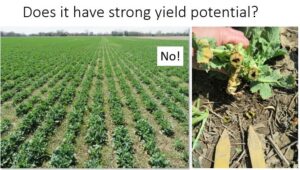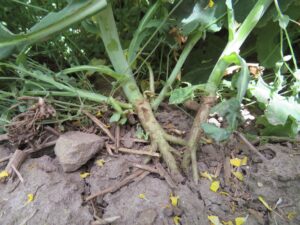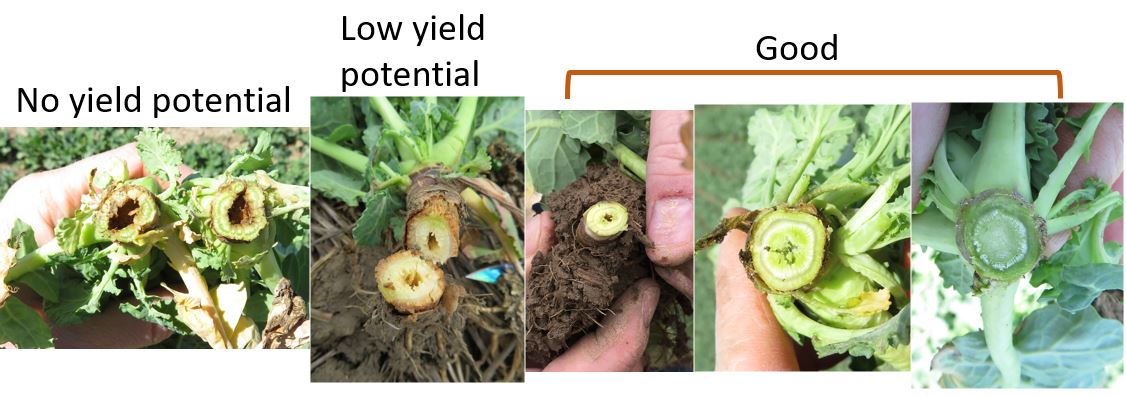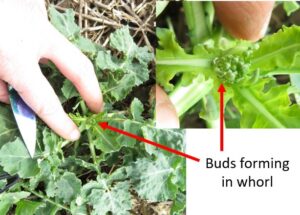When spring arrives, winter canola growers will have to scout their fields and answer 3 questions before applying fertilizer:
- Is the canola alive?
- Does it have strong yield potential?
- What is the population of healthy plants?
Scouting typically begins towards the end of March when plants start to green up. Assessments should be made after the risk of further losses from cold conditions, or fluctuating temperatures, has passed. Information from the canola breeding program at Kansas State University suggests that freezing tolerance is lost when temperatures are above 15°C for an extended period. Assessments could be made prior to temperatures reaching 15°C and above; however, if temperatures decline again you may need to scout again.
In March, if you “scout” from your truck you might jump to the conclusion that everything looks dead if the leaves have rotted off or turned brown. Some fields do not retain all the green leaves they put on in fall, especially if there was an abundance of vegetative growth. It has been observed that plants with fewer leaves (but adequate root growth) in the fall tend to retain those leaves through winter, whereas plants with many large leaves in the fall tend to lose those leaves through winter although this may depend on winter conditions and snow cover.
So, to answer Question #1 – is the canola alive: If there is any green tissue at the center of the rosette (plant crown) the plant is alive. You can also squeeze the stem just below the crown to confirm it is not rotten/mushy. By the end of March or beginning of April, dead plants will often be rotten and can be brushed away from the soil surface. Purple leaves are not necessarily a sign of poor health, as long as the growing point is green. Over time, dying plants will become a deeper and darker purple at the growing point. A strong odour is sign of rotting plants. If it is difficult to be confident in your assessments of which plants are alive vs. dead, wait a week and check again.

With winter canola, an extra step is needed to ensure the crop is both alive and healthy. Sometimes plants will be alive and growing, but have very low yield potential. So, to answer Questions #2 – does it have strong yield potential – use a knife to cut plants at the soil surface, or dig plants out of the ground and cut open along the taproot and crown. Check that the tissue inside the plants is intact and is green or white in colour. A pinhole or small hole at the center is fine, particularly if the internal tissue is still green or white. Plants with a very large hollow cavity with necrotic, brown tissue will not be able to transport water and nutrients effectively and therefore have low yield potential. These plants should not be included in the stand counts. If much of the field is damaged, it may need to be terminated.

Hollow stems are common where the plant crowns were not snug to the soil and were left exposed through the winter. After cutting a few plants to check, you can likely get a feel for how squishy the healthy vs. damaged crowns feel and switch to squeezing the base of the stem rather than cutting the stem.
Plants that are heaved out of the soil may be alive and growing, but have lower yield potential. In 2020, a field of canola heaved during cold spring conditions. Plants were not totally pushed out of the ground, but roots were exposed. The field was very uneven through flowering and pod fill, and the yield was only 1 MT/ac (2200 lb/ac). Harvest was also delayed, but cold conditions through to mid-May played a role in the delay.

Finally, before fertilizing the canola answer Question #3 – what is the population of healthy plants? Generally, the minimum acceptable population is 3 to 4 plants/ft2. Canola research in Canada is focused on the spring planted crop, and in spring canola we know that populations ranging from 5 to 20 plants/ft2 will generally result in the same yield. Canola Council have summarized research trials and state “canola crops need 30-40 plants/m2 (approx. 3 to 4 plants/ft2) to maintain yield potential”. “Stands of 50-60 plants/m2 (approx. 5 to 6 plants/ft2) yielded about five bushels per acre more than stands that averaged 20-30 plants/m2 (approx. 2 to 3 plants/ft2).”
We aim for somewhat higher populations in spring canola to buffer against stand losses to insects and diseases in the vegetative stages. However, winter canola is further along in its growth and development when those issues arise so 3 to 4 plants/ft2 is adequate for strong yields. Furthermore, it is acceptable to keep stands of 2 to 3 plants/ft2 if the weather looks good, plants look healthy when cut open, and you do not have time in your busy spring agenda to terminate the field and plant something else. In fact, Michael Stamm from Kansas State University states “A harvest population of four to 15 plants per square foot is optimum; however, a stand of one plant per square foot is acceptable although yield potential will be reduced.”
Fertilizing in Spring
Soon after green-up, winter canola will develop flower buds in the whorl of the plant and then it will bolt (stem elongation). The bolting stage is when nitrogen demand begins the steep climb towards it’s peak at the seed fill stage. Nitrogen and sulphur should be applied prior to bolting for the best nutrient use efficiency. Fertilizer should be applied as soon as you are able to get out on the field, after the plant health and population have been assessed. If fields are wet and the crop starts to bolt before fertilizer application, it is still necessary to get the fertilizer out as soon as possible. Liquid or dry fertilizer can be applied to canola.
Canola has a high nitrogen (N) requirement; about 3 lb N per bushel (3 lb N per 50 lb of grain). Approximately 1/3 of the requirement, or 30-40 lb/ac, should have been applied in the fall. A good starting point for growers that are new to canola is to apply 120 to 150 lb N/ac in the spring, or to use 70 bu/ac (3500 lb/ac) as a yield goal. Test strips of higher N rates may be helpful for future N rate decisions.
The sulphur (S) requirement is higher for canola than it is for winter wheat. Generally, 20 to 30 lb/ac of sulphate should be applied to the crop, 10 to 15 lbs of which should have been applied in the fall. Ontario winter canola fields with 15 lb S/ac or less have shown signs of sulphur deficiency (small, pale flowers). Sulphur should be applied with the nitrogen as soon as possible in spring, but rescue S can be applied up until pods start to form. Liquid or dry forms of sulphur are both effective, as long as it’s in the sulphate form and not elemental S, which will not be available to the crop.
When the canola is frozen or after it has bolted, it can be damaged by equipment tires. Use narrow tires and a wide boom, and/or avoid driving through the field while plants are frosted.
Guidelines on potassium and phosphorous for spring canola can generally be used for winter canola, and these nutrients are applied in the fall. Yield responses of canola to these nutrients are less common or are linked to low soil test values.
Check out the references below for more information. Resources on spring canola or for winter canola grown in other regions can be extremely helpful, but may need to be modified somewhat before being applied to Ontario winter canola.
- Factors involved in winter survival of canola in Kansas, K-State Research and Extension
- Plant Populations – Canola Encyclopedia, Canola Council of Canada
- Canola Growth, Development and Fertility, Washington State University
- Great Plains Canola Production Handbook, K-State Research and Extension
- Winter Canola: Why, What, Where, When & How – M. Moran 50 min presentation at IFAO 2021 virtual conference



